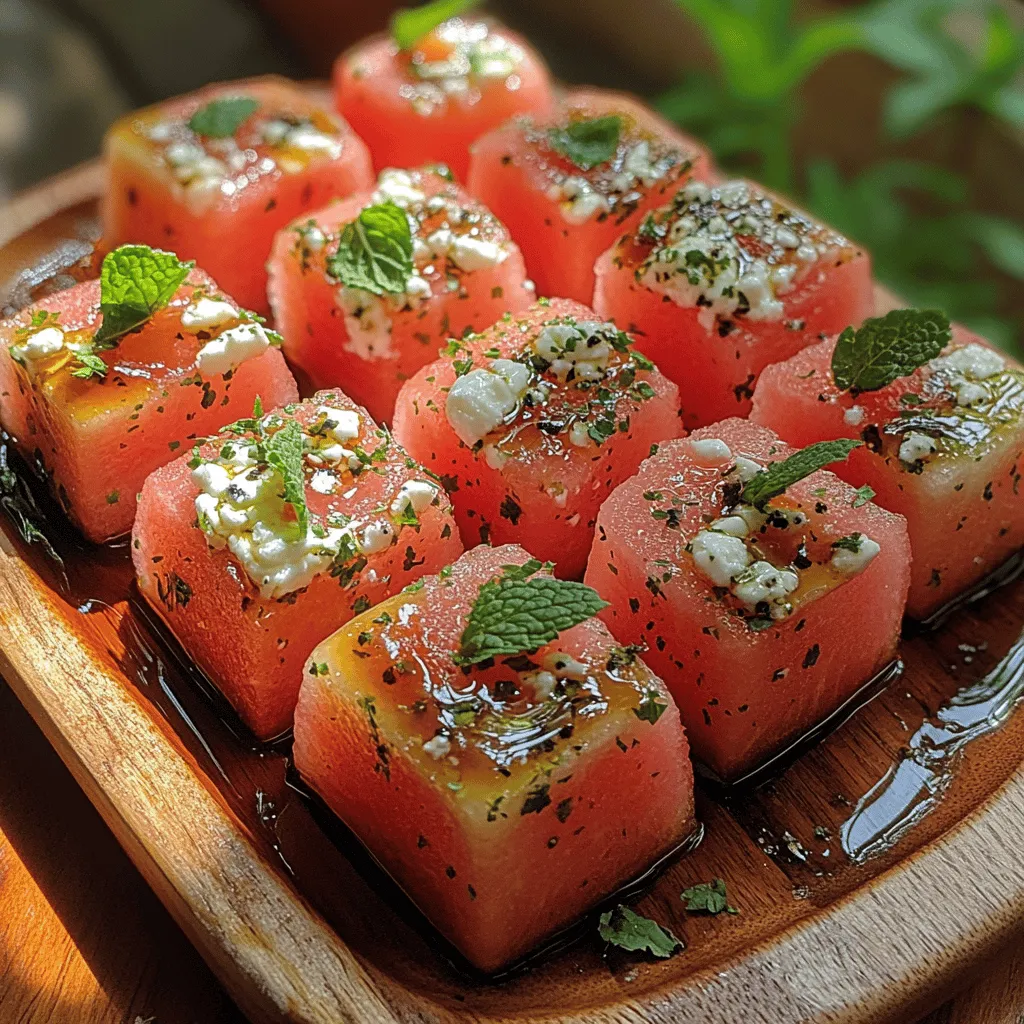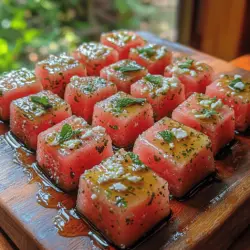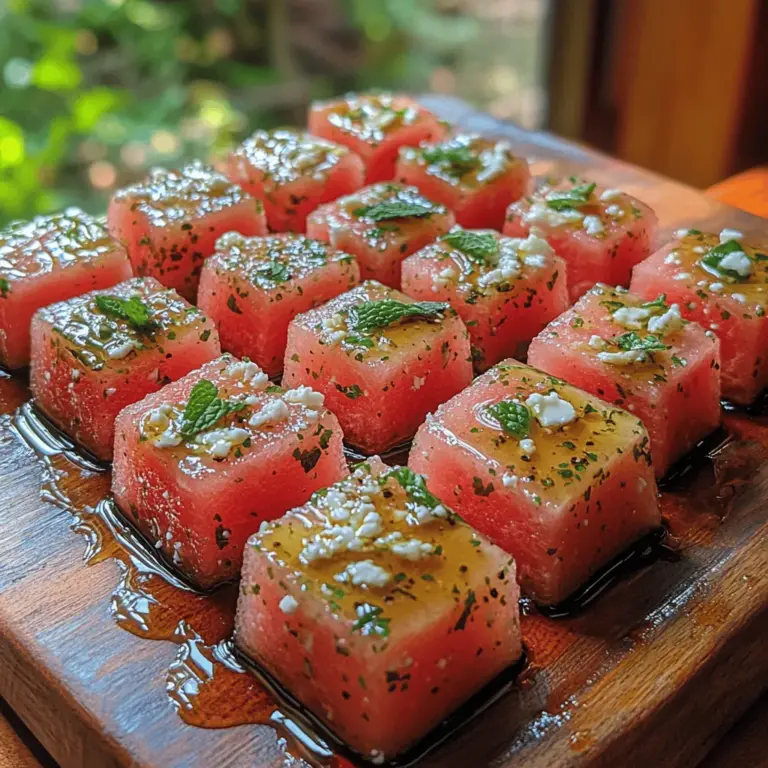Introduction
As summer approaches, nothing quite captures the essence of the season like refreshing watermelon feta bites. This vibrant dish, combining the sweetness of ripe watermelon with the salty creaminess of feta cheese, is an eye-catching appetizer that is perfect for warm-weather gatherings. Whether you are hosting a barbecue, attending a picnic, or simply enjoying a light snack, watermelon feta bites offer a delightful contrast of flavors and textures that are sure to please any palate.
Watermelon and feta cheese may seem like an unusual pairing at first, but this combination has gained popularity across various cuisines worldwide. The dish not only highlights the natural sweetness of watermelon but also elevates it with the tangy, briny notes of feta. In this article, we will provide an in-depth exploration of watermelon feta bites, including their historical significance, essential ingredients, preparation tools, and detailed cooking instructions. By the end of this guide, you’ll be equipped with all the knowledge you need to create this refreshing dish in your own kitchen.
Understanding the Recipe
Definition of the Dish
Watermelon feta bites are a simple yet elegant appetizer that typically features cubes or balls of fresh watermelon topped with crumbles or slices of feta cheese. The dish is often garnished with fresh herbs, such as mint or basil, and drizzled with a balsamic glaze or olive oil for added flavor. The beauty of watermelon feta bites lies in their simplicity, allowing the natural flavors of the ingredients to shine through while providing a visually appealing presentation.
Historical Background and Cultural Significance
The combination of watermelon and feta cheese can be traced back to various Mediterranean and Middle Eastern cuisines, where seasonal fruits are often paired with salty cheeses. In Greece, for example, the flavors of sweet watermelon and tangy feta have long been celebrated, particularly during the hot summer months. This dish not only serves as a refreshing snack but also embodies the region’s culinary philosophy of using fresh, local ingredients to create vibrant and satisfying meals.
In recent years, watermelon feta bites have gained prominence in modern cuisine, appearing on restaurant menus and at social gatherings. Their popularity can be attributed to the growing trend of incorporating fresh, seasonal ingredients into party platters and the desire for lighter, healthier options. As a result, this dish has become a staple for summer events, celebrated for its ease of preparation and the delightful burst of flavor it delivers.
Common Variations Across Different Regions
While the classic watermelon feta bites are delightful as-is, several regional variations exist that highlight different culinary influences. For instance, in some Mediterranean countries, the addition of olives, sun-dried tomatoes, or even toasted nuts can enhance the flavor profile and add depth to the dish. In other regions, a drizzle of honey or a sprinkle of chili flakes can provide an unexpected twist, balancing the sweetness of the watermelon with a hint of heat.
Vegetarian and gluten-free options are also easily adaptable, allowing individuals with dietary preferences to enjoy this dish without compromise. With its versatility and adaptability, watermelon feta bites can be tailored to suit any gathering or palate.
Key Ingredients
Overview of Essential Ingredients
To create the perfect watermelon feta bites, you will need the following essential ingredients:
1. Watermelon: The star of the dish, watermelon should be ripe and sweet, providing the refreshing base for the appetizer.
2. Feta Cheese: Creamy and tangy, feta cheese adds a savory element that contrasts beautifully with the sweetness of the watermelon.
3. Fresh Herbs: Common choices include mint or basil, which add a burst of freshness and aroma to the dish.
4. Balsamic Glaze or Olive Oil: A drizzle of balsamic glaze or high-quality olive oil can enhance the flavors and provide a glossy finish.
5. Optional Garnishes: Additional toppings, such as toasted nuts, chili flakes, or a sprinkle of sea salt, can elevate the dish further.
Importance of Each Ingredient in the Recipe
Each ingredient in watermelon feta bites plays a crucial role in achieving the perfect balance of flavors. The watermelon serves as a refreshing base that hydrates and revitalizes, especially during the summer months. Its natural sugars provide sweetness, making it the ideal complement to the salty, crumbly texture of feta cheese. The herbs not only add visual appeal but also enhance the overall flavor profile, bringing freshness and brightness to each bite.
The balsamic glaze or olive oil adds depth and richness, tying all the elements together while offering a touch of acidity that cuts through the creaminess of the feta. Optional garnishes can provide additional layers of flavor and texture, allowing for personal creativity in presentation.
Substitutions for Common Allergens or Dietary Preferences
For those who may have dietary restrictions or preferences, there are several substitutions you can make while still preserving the essence of watermelon feta bites:
– Dairy-Free Option: If you’re lactose intolerant or following a vegan diet, consider substituting feta cheese with a dairy-free cheese alternative or a blend of avocado and nutritional yeast for a creamy, cheesy texture.
– Low-Sodium Choice: For individuals monitoring their sodium intake, look for low-sodium feta cheese options or simply use fewer crumbles to limit saltiness.
– Herbal Variations: If you dislike mint or basil, try using cilantro, parsley, or even arugula for a unique twist.
– Nut-Free Version: For those with nut allergies, simply omit any nuts from the recipe without compromising the overall flavor.
Preparation Tools and Equipment
List of Necessary Kitchen Tools
Before diving into the cooking process, it’s essential to gather the necessary tools to ensure a smooth and enjoyable preparation experience. Here’s what you’ll need:
1. Cutting Board: A sturdy, flat surface for chopping and prepping ingredients.
2. Sharp Knife: A reliable knife is critical for easily slicing through watermelon and crumbling feta cheese.
3. Melon Baller or Cookie Cutter: Optional, but useful for creating perfectly shaped watermelon balls or fun shapes for presentation.
4. Mixing Bowl: To combine any additional ingredients, such as herbs and dressings.
5. Serving Platter: An attractive platter for presenting your finished watermelon feta bites.
Importance of Each Tool in the Cooking Process
Having the right tools on hand can make all the difference in your cooking experience. A sharp knife ensures clean cuts, allowing you to create uniform pieces of watermelon and feta cheese that enhance the visual appeal of the dish. A cutting board provides a safe and stable surface for chopping, while a mixing bowl allows for easy incorporation of flavors and dressings.
Using a melon baller or cookie cutter can elevate the presentation of your bites, making them more appealing for guests. Finally, a beautiful serving platter will showcase your creation and make it more inviting, encouraging everyone to indulge in this fresh summer treat.
Tips for Choosing the Right Equipment
When selecting kitchen tools, opt for high-quality materials that will endure frequent use. A sturdy cutting board made from wood or bamboo is preferable for its durability and knife-friendly surface. Ensure your knife is sharp and well-balanced for ease of use and safety.
If using a melon baller, look for one with a comfortable grip to make the process enjoyable, and choose a serving platter that complements your table setting. Remember, the right tools can enhance not only the cooking process but also the overall presentation of your dish.
Step-by-Step Cooking Instructions
Now that you have gathered all the necessary ingredients and tools, it’s time to dive into the preparation and cooking process for watermelon feta bites. Follow these detailed instructions to create this refreshing appetizer.
Preparation Stage
1. Washing Ingredients: Start by thoroughly washing your watermelon under cool running water to remove any dirt or contaminants. This is particularly important since the skin will come into contact with your knife during preparation.
2. Chopping Ingredients: Using your sharp knife, cut the watermelon in half lengthwise, then slice it into quarters. From there, carefully cut the flesh into cubes or use a melon baller to create fun, bite-sized balls. Aim for uniform pieces to ensure even serving sizes.
3. Pre-measuring Spices and Other Components: If you plan to use a balsamic glaze or olive oil, measure out the desired amount in a small bowl. If you’re incorporating herbs, chop them finely to release their aromatic oils and enhance the flavor of the dish.
Cooking Stage
1. Combining Ingredients: In a mixing bowl, gently toss the watermelon pieces with the crumbled feta cheese, being careful not to mash the watermelon. If you’re using herbs, add them in at this stage for an even distribution of flavor.
2. Drizzling: Once your watermelon and feta are combined, drizzle the balsamic glaze or olive oil over the mixture. Use a spoon to gently fold the ingredients together, ensuring that all the components are well-coated without breaking apart the watermelon.
3. Timing and Temperature Guidelines: While watermelon feta bites can be served immediately, allowing them to chill for about 15-30 minutes in the refrigerator can enhance the flavors and provide a refreshing temperature that is ideal for summer enjoyment.
Plating and Presentation
When it’s time to serve, transfer your watermelon feta mixture onto a serving platter, arranging it artfully for visual appeal. Consider garnishing with additional fresh herbs, a sprinkle of sea salt, or even a few toasted nuts to elevate the presentation. If desired, provide toothpicks for easy serving, allowing guests to enjoy these delightful bites with minimal mess.
As you prepare to share this refreshing dish with family and friends, remember that the combination of sweet watermelon and creamy feta cheese is not only a treat for the taste buds but also a feast for the eyes. Watermelon feta bites are the perfect way to celebrate the flavors of summer and enjoy the company of loved ones.
Stay tuned for more tips and variations as we continue to explore the wonderful world of watermelon feta bites in the next part of this article.

Tips for Garnishing
Garnishing your Watermelon Feta Bites can elevate their presentation and enhance their flavor profile. Here are some creative ideas to make your dish even more visually appealing and delicious:
1. Fresh Herbs: Sprinkling fresh mint or basil leaves on top of your bites not only adds a pop of color but also complements the sweetness of the watermelon and the tanginess of the feta. Chopped herbs can be a quick and effective garnish.
2. Drizzle of Balsamic Reduction: A light drizzle of balsamic reduction adds a rich, sweet-tart flavor that balances the dish beautifully. It also brings an elegant touch and enhances the overall presentation.
3. Chili Flakes or Fresh Pepper: For those who enjoy a bit of heat, a sprinkle of crushed red pepper flakes or a few slices of fresh jalapeño can bring an exciting kick to the bites, adding depth to the flavor without overpowering it.
4. Toasted Nuts or Seeds: Adding a sprinkle of toasted pine nuts, pistachios, or sunflower seeds can provide a delightful crunch and an extra layer of flavor. Toasting them lightly will enhance their taste and aroma.
Suggestions for Serving
Watermelon Feta Bites are incredibly versatile and can be enjoyed in various settings. Here are some suggestions for serving them:
1. Appetizer for Gatherings: These bites make for a perfect appetizer at parties, barbecues, or family gatherings. Their refreshing taste is a crowd-pleaser, especially during the warmer months.
2. Picnic Perfect: Pack these bites for a picnic! They are easy to transport and require no utensils, making them an ideal finger food for outdoor events.
3. Light Lunch or Snack: Serve them as a light lunch option, perhaps alongside a simple green salad. They can also be a refreshing snack between meals, providing a balance of hydration and nutrients.
4. Brunch Delight: Incorporate Watermelon Feta Bites into a brunch spread. Pair them with other light dishes like a fruit salad, yogurt parfaits, or a selection of pastries.
Flavor Profiles and Taste Enhancements
Understanding the flavor profiles of Watermelon Feta Bites is crucial for enhancing your dish:
1. Sweet and Savory Balance: The sweetness of the watermelon beautifully contrasts with the salty creaminess of the feta cheese. This sweet-savory combination is what makes these bites so appealing. You can experiment with this balance by adjusting the feta’s quantity or choosing a more robust cheese.
2. Acidity and Freshness: Adding a splash of lime or lemon juice can brighten the overall flavor. The acidity cuts through the richness of the feta and enhances the freshness of the watermelon.
3. Adjusting to Personal Taste: Don’t hesitate to personalize the recipe. If you prefer a creamier texture, consider using a whipped feta or blending feta with Greek yogurt. For those who enjoy a bit of zest, adding citrus zest or different herbs can bring a whole new dimension to the dish.
4. Pairing Suggestions: Watermelon Feta Bites pair wonderfully with various side dishes and beverages. Serve them alongside grilled meats, seafood, or a light pasta salad. As for drinks, they complement crisp white wines, refreshing cocktails, or even flavored sparkling waters.
Nutritional Information
Watermelon Feta Bites are not only delicious but also packed with nutritional benefits. Here’s a breakdown of their nutritional value:
1. Calories: Each bite is low in calories, making them a guilt-free snack option. A typical serving of three bites contains approximately 100 calories.
2. Macronutrients:
– Fats: The healthy fats from feta cheese contribute to about 6 grams per serving, providing essential fatty acids.
– Proteins: Feta adds about 4 grams of protein per serving, which is beneficial for muscle maintenance and overall health.
– Carbohydrates: With watermelon being primarily water, these bites contain around 10 grams of carbohydrates. Watermelon is also a good source of hydration, with a water content of about 90%.
3. Benefits of Main Ingredients:
– Watermelon: Rich in vitamins A and C, watermelon also contains antioxidants like lycopene, which may help reduce inflammation.
– Feta Cheese: Feta is a good source of calcium and protein, contributing to bone health and muscle function.
Common Mistakes and Troubleshooting
Even the simplest recipes can encounter a few bumps along the way. Here are some common mistakes to watch out for and tips to avoid them:
1. Choosing the Wrong Watermelon: Selecting an unripe or overripe watermelon can affect the taste. Look for watermelons that are symmetrical, feel heavy for their size, and have a uniform shape. A yellow spot on the bottom indicates ripeness.
2. Feta Texture: If your feta is too crumbly, it may not adhere well to the watermelon. Consider using a creamier feta or crumbling it just before serving to maintain its texture.
3. Overseasoning: It’s easy to go overboard with seasoning. Start with a small amount of salt or herbs and adjust to taste. Remember, feta is already salty, so you might not need much additional salt.
4. Salvaging the Dish: If you find that your bites are too salty or bland, you can balance the flavors by adding more watermelon or a drizzle of honey to offset the saltiness. If the presentation doesn’t meet your expectations, consider arranging the bites on a platter with garnishes for a more appealing look.
Storage and Reheating Tips
Storing your Watermelon Feta Bites properly ensures they remain fresh for your next snack. Here are some best practices:
1. Storing Leftovers: If you have leftover bites, store them in an airtight container in the refrigerator. They can last up to 2 days. However, they are best enjoyed fresh, as the watermelon may release moisture and affect the texture of the feta.
2. Reheating Methods: Generally, these bites are served cold, so there’s no need to reheat them. If you prefer a warm version, you could briefly heat the feta in a microwave, but it’s recommended to serve them at room temperature to maintain the freshness of the watermelon.
3. Signs of Spoilage: Always check for signs of spoilage before consuming. If the watermelon appears mushy or has an off smell, it’s best to discard it. Feta can also spoil; look for mold or sour smells as indicators that it’s time to throw it out.
Conclusion
Watermelon Feta Bites are a delightful blend of flavors that offer a refreshing and nutritious snack or appetizer. Their versatility makes them suitable for a variety of occasions, from casual picnics to elegant dinner parties. With the right garnishing and serving suggestions, you can impress your guests and satisfy your taste buds.
Encouraging experimentation with flavors and ingredients will allow you to adapt this dish to your personal preferences, ensuring it remains a staple in your recipe repertoire. So why not give this recipe a try? Dive into the delicious world of Watermelon Feta Bites, and don’t hesitate to explore variations that fit your unique taste. Enjoy!

